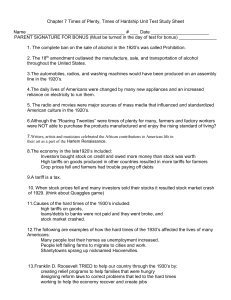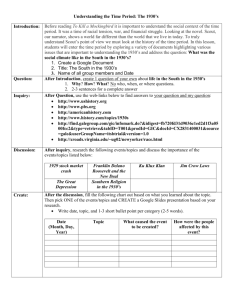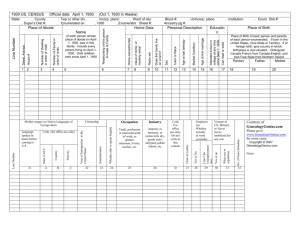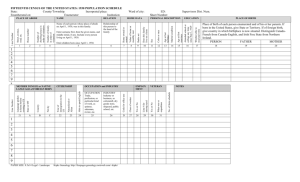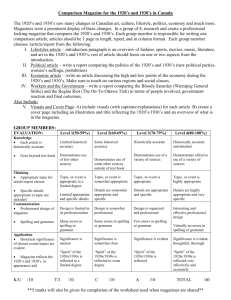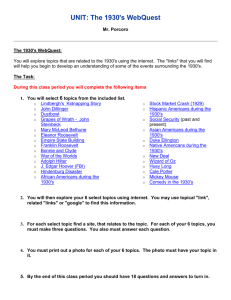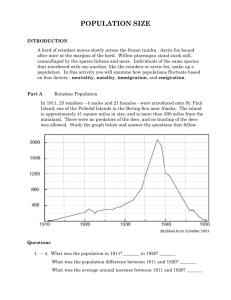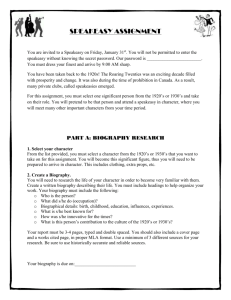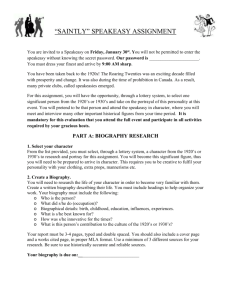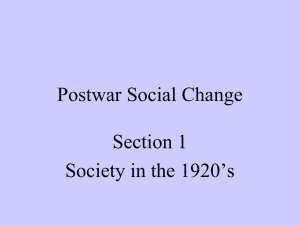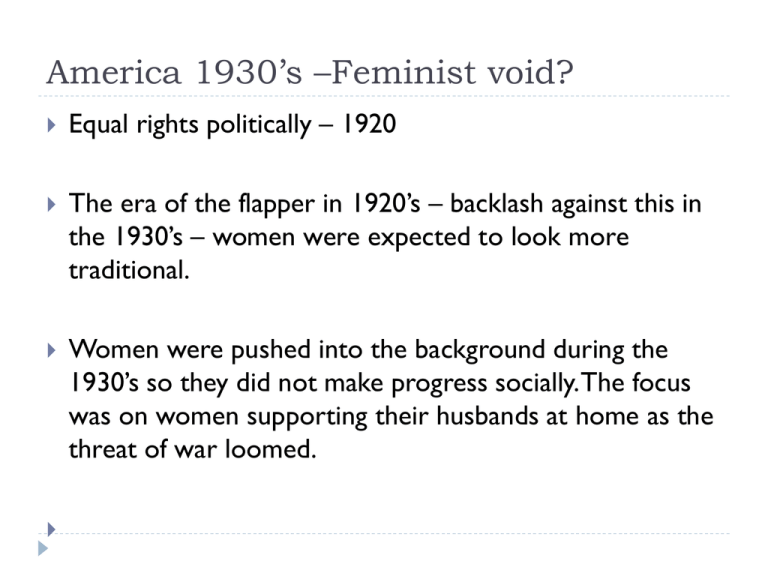
America 1930’s –Feminist void?
Equal rights politically – 1920
The era of the flapper in 1920’s – backlash against this in
the 1930’s – women were expected to look more
traditional.
Women were pushed into the background during the
1930’s so they did not make progress socially. The focus
was on women supporting their husbands at home as the
threat of war loomed.
Women
The new women of the 1920’s were forgotten.
The 19th amendment in 1920 meant women had the right
to vote and women's rights movements were prevalent.
Women were presented with crimson lips, short hair and
little clothing – it was an age of female enlightenment.
The Wall Street Crash – The depression
The Great Depression and the rise of communism and fascism
around the world meant women in America stepped back into their
kitchens in 1920.
Women were seen as a threat employment wise.
Women lost their motivation to fight for equal rights in the 1930s.
Many felt they had gained this with the right to vote.
The League of Women voters President thought that in 1930 “nearly
all discriminations have been removed.”
BUT this could not have been further from the truth as the
depression made women even more unpopular with men than they
had been before.
Feminism – what feminism?
Women failed to vote in bloc.
Many women still considered politics a man’s concern and
most women did not have the motivation to challenge
this view.
Those women involved in politics focused on the peace
movement.
In 1930’s America in some states husbands had complete
control of their wife’s wages.
Roosevelt appointed the first female woman cabinet
member (Frances Perkins) but she herself said “women
ought not shirk their responsibilities to their families by
seeking outside employment.”
Feminists flattered and patronised by
Nock
There were some women keen to build on the feminist
movement of the 1920’s.
But they had to fight against an antagonistic majority of
their society who felt that women needed to stay at
home and look after their husbands as “Women can
civilize a society and men cannot.”
This quote is from Albert Jay Nock whose views mirrored
those of society at the time.
“Only in molding their young ones and prodding their
husbands toward responsible action could women serve
their natural purpose.”
Women – a threat to society
Women posed as competition for men in the work place.
Men resented women looking for and receiving employment.
Efforts were made to remove women from the work force.
1932 – American anti nepotism law: only one spouse could work. ¾
workers fired under this rule were women.
Even prominent women were sexist towards women – “A home no
matter how small, is large enough to occupy a wife’s mind and time.”
Mrs Samuel Gompers
During the 1930’s, the percentage of masters and PHDs earned by
women dropped significantly.
Comprehensive (broad education) education was replaced with
domestic education (cooking and cleaning lessons)
Without adequate training or public support, the 1930’s working
woman faced numerous obstacles in fighting for a suitable job.
Here come the girls
But despite all of these set backs for feminism, there were
50% more women in the work force than there were in
the 1920’s. There were also some stay at home husbands.
The jobs they could get, however, were basic –
Factory and clerical work
Domestic and personal services
Apparel and canning factories
And…………………………………….
Teaching!
A male teacher in 1939 earned $1,953 per year.
A female teacher in 1939 earned $1,394 per year.
So – whilst women worked during the depression, their
status actually lowered.
Attention was focused on reviving a flagging economy and
the twenties optimism for feminism died out.
Eleanor Roosevelt
Powerful woman
Politically minded
Worked for the Women’s Trade Union League
She campaigned against racial and sexual discrimination
She campaigned against lynching but her husband did not support
her politically as he was concerned supporting this move would
mean he would lose the white vote in the south.
In 1930’s America, even powerful women like Roosevelt were
prevented from realising their potential.
Curley’s wife
Traditional feminine appearance common in the 1930’s.
Trapped in unemployment.
Treated as though she should be entirely committed to
her husband and not leave the house.
Given little opportunity to further herself – no
training/educational opportunities.
Curley’s wife epitomises what life was like in 1930’s
America for your average American woman

